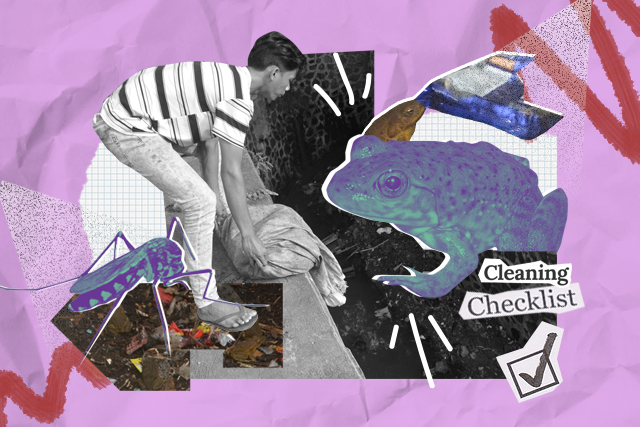
Barangay officials in Quezon City released bullfrogs in hopes of cleaning a waterway rather than cleaning it themselves.
Based on the village’s official Facebook page, Barangay Captain Allan Franza of Old Balara led the release of at least 1,000 bullfrogs to combat the spread of dengue, the disease that became a national epidemic this month, in polluted estuaries of their jurisdiction last August 20.
“Naniniwala si Kap. Franza na maaring mapigilan ang pagdami ng mga lamok sa panamagitan ng pagkalat ng mga palaka na syang kakain sa naturang insekto,” the caption of the post read.
Kap. Allan Franza pinangunahan ang pagpapakalat ng mga palaka o bull frog sa mga estero at matubig na lugar sa Brgy. Matandang Balara upang pigilan ang pagdami ng mga lamok na may dalang dengue naniniwala si kap. Franza na maaring mapigilan ang pagdami ng mga lamok sa panamagitan ng pagkalat ng mga palaka na syang kakain sa naturang insektoAUG20,2019
Posted by Barangay Matandang Balara – Action Forward on Wednesday, August 21, 2019
Bullfrogs, particularly the North American variety, are large carnivorous predators that are capable to eat other creatures that fit in their mouths whether snakes or insects.
While their intentions are good, what the local government did was make introduce an “invasive” creature to the environment.
This was pointed out by some concerned Filipinos online.
“Bullfrogs are invasive. An invasive species is defined as an introduced species that out-competes native species for space and resources and whose introduction or spread threatens the environment, the economy and/or society,” one Twitter user said.
Bullfrogs are invasive. An invasive species is defined as an introduced species that out-competes native species for space and resources and whose introduction or spread threatens the environment, the economy and/or society. https://t.co/EeKHoysuOU
— Nothing (@FindingModi) August 25, 2019
Earlier this month, a state-run agency also conducted a mass distribution of mosquitofish to several schools in Pangasinan as counter measure against dengue.
The National Integrated Fisheries Technology Development Center of the Bureau of Fisheries and Aquatic Resources released around 6,000 mosquito fish stocks into the schools’ drainage ditches, canals and other stagnant waterways.
Dr. Westley Rosario, director of the figheries center, explained that the fishes were first introduced to the Philippines in 1905 and to other countries during World War II to fight malaria, another disease acquired from mosquito bites.
Mosquito fishes, however, are considered among the most invasive species in the world due to their ability to easily adapt to any environment, according to the University of the Philippines-Alliance of Advocates for the General Welfare of Animals or UP Alaga on Facebook.
“The UP Alliance of Advocates for the General Welfare of Animals (UP ALAGA) firmly opposes the introduction of mosquito fish to freshwater bodies in the Philippines. We urge the government to immediately but cautiously address the dengue problem with a proactive and research-based approach,” the group said.
𝗦𝘁𝗮𝘁𝗲𝗺𝗲𝗻𝘁 𝗼𝗻 𝘁𝗵𝗲 𝗥𝗲𝗹𝗲𝗮𝘀𝗲 𝗼𝗳 𝗠𝗼𝘀𝗾𝘂𝗶𝘁𝗼𝗳𝗶𝘀𝗵 𝗶𝗻 𝗣𝗮𝗻𝗴𝗮𝘀𝗶𝗻𝗮𝗻As a response to the national dengue epidemic, the National…
Posted by UP Alliance of Advocates for the General Welfare of Animals – UP ALAGA on Saturday, August 24, 2019
The Department of Health made the national epidemic announcement after at least 146,000 cases, including 622 deaths, were recorded from January to July 20 this year.
Like an alien invasion
A species can be considered invasive if it is not native to an ecosystem and that it causes harm to the native species, particularly the endangered ones.
“They can harm the environment, the economy, or even human health. Species that grow and reproduce quickly, and spread aggressively, with potential to cause harm, are given the label ‘invasive,’” the National Wildlife Federation said.
Bullfrogs
The rapid population growth of American bullfrogs in several countries started to concern scientists in 2004.
The lack of predators to regulate their numbers allowed them to propagate faster.
According to the National Geographic, these amphibians can lay as many as 20,000 eggs and considered as the worst invasive species on Earth.
“They will ambush and eat just about anything they can fit in their ample mouths, including insects, mice, fish, birds, and snakes. They sit quietly and wait for prey to pass by, then lunge with their powerful hind legs, mouths open wide,” the article said.
Mosquito fish
The Eastern gambusia (Gambusia holbrooki), also known as the mosquito fish, had been used to control disease-carrying mosquitoes since the 1920s, according to an article from Physics.org.
However, the International Union for Conservation of Nature or IUCN considered it one of the world’s 100 most harmful species in the world due to its ability to adapt and reproduce faster than the native species of an ecosystem.
In 2016, some ecologists raised the alarm of the guppies of mosquito fish threatening the biodiversity of the places they are dumped into.
“Guppy-rich areas showed increased levels of dissolved nitrogen—from ammonium in fish urine and gill excretions—which, in turn, stimulated algae growth,” an article from Science magazine said. —Artwork by Uela Altar-Badayos









